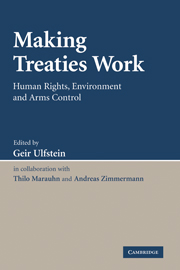Book contents
- Frontmatter
- Contents
- Preface and acknowledgments
- Notes on the contributors
- Table of cases
- Table of treaties and other international instruments
- INTRODUCTION
- PART I INTERNATIONAL HUMAN RIGHTS
- PART II INTERNATIONAL ENVIRONMENTAL LAW
- 5 Dispute resolution, compliance control and enforcement in international environmental law
- 6 The Convention on International Trade in Endangered Species of Wild Fauna and Flora (CITES)
- 7 The Convention on Long-Range Transboundary Air Pollution
- 8 The Convention on Access to Information, Public Participation in Decision-Making and Access to Justice in Environmental Matters (Aarhus Convention)
- 9 The Convention on Environmental Impact Assessment in a Transboundary Context (Espoo Convention)
- PART III INTERNATIONAL ARMS CONTROL
- GENERAL COMMENTS
- Index
5 - Dispute resolution, compliance control and enforcement in international environmental law
Published online by Cambridge University Press: 05 September 2009
- Frontmatter
- Contents
- Preface and acknowledgments
- Notes on the contributors
- Table of cases
- Table of treaties and other international instruments
- INTRODUCTION
- PART I INTERNATIONAL HUMAN RIGHTS
- PART II INTERNATIONAL ENVIRONMENTAL LAW
- 5 Dispute resolution, compliance control and enforcement in international environmental law
- 6 The Convention on International Trade in Endangered Species of Wild Fauna and Flora (CITES)
- 7 The Convention on Long-Range Transboundary Air Pollution
- 8 The Convention on Access to Information, Public Participation in Decision-Making and Access to Justice in Environmental Matters (Aarhus Convention)
- 9 The Convention on Environmental Impact Assessment in a Transboundary Context (Espoo Convention)
- PART III INTERNATIONAL ARMS CONTROL
- GENERAL COMMENTS
- Index
Summary
Introduction
The world has experienced a growing awareness of environmental degradation since the 1960s. These concerns were reflected at the political level by the 1972 Stockholm Conference on the Human Environment, the 1992 Rio Conference on Environment and Development, and, finally, the 2002 Johannesburg World Summit on Sustainable Development. The legal response has been a steep proliferation in the number of multilateral environmental agreements (MEAs). While there is no environmental agreement setting out the general obligations of States to protect the environment, the MEAs represent a sectoral approach, covering diverse aspects of nature conservation and pollution prevention.
The agreements apply a ‘sustainable development’ approach to environmental protection, meaning that nature may be used in the interest of humankind, but such use should be sustainable in the long term. Furthermore, special consideration should be given to developing countries based on the principle of ‘common but differentiated responsibilities’, i.e. that the developed countries have accepted a special responsibility ‘in view of the pressures their societies place on the global environment and of the technologies and financial resources they command’. It should be noted that environmental protection is increasingly a matter of social and economic significance also in developed countries, such as restrictions on energy consumption in both industry and the private sector to protect against climate change.
MEAs are generally policy-oriented in establishing co-operative organs, in the form of a Conference of the Parties (COP), subsidiary bodies and a secretariat.
- Type
- Chapter
- Information
- Making Treaties WorkHuman Rights, Environment and Arms Control, pp. 115 - 133Publisher: Cambridge University PressPrint publication year: 2007
- 5
- Cited by

